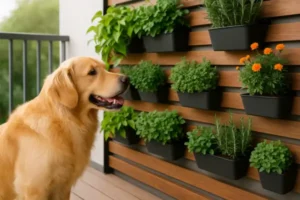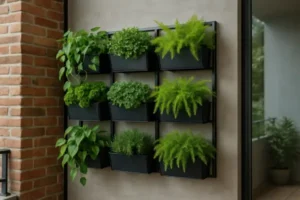A seasonal planting guide for vertical gardens helps you choose the right plants at the right time for a thriving green space all year. Whether you’re growing herbs, vegetables, or ornamental plants, seasonal strategy makes all the difference.
Each season brings unique conditions—sunlight, temperature, humidity—that affect plant growth. With a little planning, your vertical garden can be a constant source of freshness and beauty.
Even if you have a small space, like a modular vertical garden for gourmet balconies, using seasonal insight helps maximize your garden’s potential and keeps it vibrant from spring through winter.
Seasonal Planting Guide for Vertical Gardens: How the Seasons Shape Success
Planning with the seasons brings harmony to your vertical garden. Instead of forcing results, you begin to work with natural cycles—choosing what to plant, when to plant, and how to care for each stage with more ease and intention.
Each part of the year supports a different kind of energy. In spring, everything begins again. Summer pushes growth forward. Autumn helps you slow down and reorganize. Winter becomes a time to pause, reset, and observe. When your garden reflects that rhythm, it stays active, balanced, and easier to manage.
This approach doesn’t require a large space or expert knowledge—just attention to the time of year and the behavior of your plants. Over time, you’ll notice how even small changes in daylight or temperature influence what thrives and what fades. With that awareness, your decisions become clearer, and your garden becomes stronger season after season.
Spring: Awakening Your Vertical Garden After Winter
Spring is the season of renewal—and the best time to refresh your vertical garden with new life. As daylight increases and temperatures rise, the soil warms and your plants get the message: it’s time to grow.

This is a great opportunity to reset your structure. Clean out old roots, replace compacted soil in pockets, and inspect your irrigation system. Spring is when your preparation determines your results for the entire year.
Ideal plants for spring include:
- Leafy greens: spinach, arugula, lettuce
- Early vegetables: peas, radishes, carrots
- Fragrant herbs: basil, mint, dill, chives
- Cool-season flowers: pansies, violas, snapdragons
Start with fast growers like radishes and spinach on the top tiers of your garden, where they’ll get the most light. Herbs thrive in middle rows, and moisture-loving flowers like pansies can sit comfortably lower.
Spring also invites companion planting. Pairing basil with lettuce or peas with carrots boosts performance and deters pests. The warmer air, combined with spring rains, gives a huge growth advantage—but don’t forget late frost risks. Keep frost covers on hand for safety during transitional weeks.
Once your vertical structure is clean, replanted, and watered, you’ll start to see new shoots emerge in just a few days. Keep pruning regularly to encourage bushy growth and reduce disease.
Summer: Managing Heat, Growth, and Watering
Summer is both a blessing and a challenge. With long sunny days, your vertical garden hits its peak growth stage. However, high temperatures and intense sun can also cause stress if you’re not prepared.
This is the season when your garden requires the most hands-on care. It’s not only about planting; it’s about maintaining healthy hydration, airflow, and protection from overheating.
Top summer plants for vertical gardens include:
- Sun-loving herbs: rosemary, thyme, oregano
- Vegetables: cherry tomatoes, peppers, cucumbers
- Drought-resistant greens: Swiss chard, purslane
- Tropical or semi-shade ornamentals: coleus, ferns
Start your summer routine by assessing water flow. Drip irrigation systems work great in a modular vertical garden for gourmet balconies, helping you deliver consistent moisture without overdoing it.
Next, think shade. Add temporary shade cloths or adjust the positioning of your pots to shield delicate plants. Place drought-tolerant herbs and succulents in the top pockets—these areas dry out fastest and receive the most sunlight. Reserve middle levels for veggies that like balance, and lower tiers for anything that prefers partial shade.
Insects are more active in summer. Monitor daily and introduce organic deterrents such as neem oil or garlic spray. Harvest regularly to encourage more fruiting and prevent rot, especially in dense plantings.
With a bit of routine, your summer vertical garden can be overflowing with flavor, scent, and color. Just remember: more heat = more evaporation. Stay alert and consistent.
Autumn: Transitioning Toward Rest Without Losing Beauty
Autumn is often overlooked in garden planning, but it’s a golden opportunity to keep your vertical garden alive while prepping it for rest. As temperatures cool and days shorten, you can plant hearty crops that thrive in the fall.
Before planting anything new, clear away dying summer growth. Compost what you can and sterilize containers that housed diseased plants. Autumn is also the perfect time to enrich the soil again with compost, worm castings, or organic fertilizers.
Excellent plant choices for fall include:
- Hardy greens: kale, mustard greens, spinach
- Root crops: beets, turnips, radishes
- Herbs: cilantro, parsley
- Cold-tolerant blooms: marigolds, calendula, violas
Take advantage of the cooler weather to grow nutrient-rich crops that don’t bolt in heat. These are ideal for the middle to bottom tiers, where they’re shielded from cooler winds and retain moisture longer.
Use this time to test your modular vertical garden for gourmet balconies layout. As you plant slower-growing crops, evaluate what worked and didn’t over spring and summer. You can move modular units, swap in fresh liners, or reposition herbs closer to your kitchen for ease of use during winter.
Autumn is also great for sowing perennials that will bloom again in spring. With a little attention, your vertical garden remains productive and attractive well into the cooler months.
Winter: Protect, Pause, and Plan
While many gardeners abandon their spaces in winter, vertical gardening doesn’t need to stop completely. With smart choices and protective strategies, your garden can still offer value—even if in a quieter way.
Winter demands less planting and more caretaking. It’s about safeguarding your structure, maintaining essential growth, and—if you’re lucky enough to have an indoor vertical wall—keeping herbs fresh at arm’s reach.
Recommended winter plantings:
- Cold-hardy herbs: sage, thyme, oregano
- Greens: kale, endive, mache (corn salad)
- Evergreens: dwarf conifers, ivy
- Indoor verticals: pothos, spider plant, ZZ plant
For outdoor balconies, use breathable fleece to cover your garden, especially on windy or freezing nights. Raise planters off the ground slightly to prevent root freeze and reduce mold buildup. Cut back perennials and mulch roots where needed.
If your vertical garden is indoors, winter is a good time to experiment with lighting. Install LED grow lights with a warm spectrum to keep herbs and leafy greens going. Keep windows clean to maximize natural sunlight.
Beyond maintenance, winter is when planning begins. Use this time to sketch layouts, review seasonal notes, and order seeds for the year ahead. A garden that rests well in winter is stronger and more productive when spring returns.
Designing Your Vertical Garden With the Seasons in Mind
One of the greatest advantages of vertical gardening is how customizable it is. But to get the most out of it, you need to design your structure to respond to seasonal shifts—not just visually, but functionally.
This means thinking vertically with intention. The layout should serve your plants as temperatures change, water needs shift, and sunlight exposure varies.
In a modular vertical garden for gourmet balconies, flexibility is your biggest ally. You can rearrange components, rotate plant pockets, and update your system to suit what the season demands. Here’s a practical way to break it down:
Top Tiers (maximum sun exposure and wind exposure):
- Best for drought-tolerant plants like rosemary, oregano, and succulents.
- Summer crops such as cherry tomatoes and peppers also perform well here.
- In winter, this tier needs protective covering to avoid frost damage.
Middle Tiers (moderate sun and temperature stability):
- Ideal for leafy greens like spinach, arugula, and Swiss chard.
- Herbs such as basil, parsley, and mint thrive in this balanced zone.
- In colder months, hardy root vegetables and kale do especially well here.
Lower Tiers (cooler and more humid environment):
- Suitable for ferns, lettuces, and shade-loving flowers like nasturtiums.
- Retains more moisture, so it’s a great spot during hot summers.
- Works well for overwintering perennials in mild climates.
By assigning each plant to the right tier based on its seasonal preference, you create a garden that adapts naturally—reducing stress, improving yield, and minimizing the need for constant intervention.
Also consider environmental conditions specific to your space: balcony orientation, exposure to rain, or surrounding buildings that block the sun. These microclimates influence how each level performs throughout the year.
Using Companion Planting Through the Seasons
While timing and placement are vital, choosing the right plant neighbors can significantly impact your garden’s health. This practice, known as companion planting, supports growth, deters pests, and improves flavor—all within the tight quarters of a vertical system.
Let’s look at seasonal pairings that work well in vertical gardens:
Spring Companion Suggestions
Spring is all about energy and fast development. It’s the season when light returns, temperatures rise, and plants respond quickly. Choosing the right companions helps maximize this momentum and create balance within each vertical module.
Lettuce + Radish + Chives
This trio works beautifully. Radishes grow fast and help loosen compact soil, creating better conditions for shallow-rooted lettuce. Chives not only fit well in vertical pockets but also help deter aphids and other pests, supporting the entire group.
Peas + Carrots
Peas grow upward, saving space and casting light shade that benefits slower crops. Carrots quietly develop underground, undisturbed. Together, they make efficient use of both vertical and root zones.
Use these combinations to start your spring garden with structure and synergy. Companion planting isn’t just about saving space—it’s about building a healthier, more resilient system from the start.
Summer Companion Suggestions
Summer brings strong sun, fast growth, and a surge in garden activity—but also more pests and higher water demands. Choosing smart plant combinations during this season helps create a more balanced vertical garden, where species support each other naturally.
Cucumber + Dill + Marigold
This trio works on multiple levels. Dill attracts pollinators and beneficial insects like ladybugs, which help control aphids. Marigolds release natural compounds that repel nematodes in the soil, while their bright flowers attract hoverflies that prey on common pests. Meanwhile, cucumbers grow vigorously and benefit from the extra insect activity around them.
Tomato + Basil
A classic pairing with real benefits. Basil helps mask the scent of tomatoes, confusing whiteflies and reducing infestations. It also encourages better pollination and may even enhance the flavor of the tomatoes themselves. Both enjoy full sun and frequent watering, making them ideal neighbors.
These combinations thrive in the top tiers of your vertical structure, where sunlight is strongest and airflow is better. By pairing plants that support each other’s growth and protection, your summer garden becomes more efficient, more aromatic, and a lot easier to care for.t growth.
Fall Companion Suggestions
Autumn calls for sturdy plants that can handle shifting temperatures while helping the garden settle into a slower rhythm. The goal is to support soil health, manage moisture, and keep the system productive as light begins to fade.
Kale + Beets + Garlic
Kale thrives in cooler air, and when paired with beets and garlic, it gets an added boost. Beets help aerate the soil, while garlic naturally repels pests and adds underground structure. Together, they support strong, resilient growth.
Turnips + Parsley
Turnips grow downward, using deep space efficiently, while parsley spreads across the surface, helping retain warmth and moisture. It’s a simple but effective pairing that keeps the soil protected and active.
These combinations perform well in the middle tiers of your vertical garden—where sunlight is softer, and the temperature remains stable enough to encourage steady growth through the season.
Winter Indoor Suggestions
In colder months, indoor vertical gardens become a quiet but steady part of your space. Companion planting during winter helps regulate moisture, improves air quality, and keeps your setup feeling alive—even with limited daylight.
Mint + Sage
Both herbs enjoy cooler indoor temperatures and adapt well to vertical planters. Mint brings a crisp, refreshing scent, while sage adds warmth and texture. Juntas, ajudam a manter o ar mais limpo e o ambiente mais acolhedor.
Pothos + ZZ Plant
These two are champions of low-maintenance indoor gardening. They thrive with little light, require minimal watering, and help purify the air. Their different shapes and shades of green also create a lush, layered look.
These winter pairings aren’t just decorative—they help maintain rhythm and care through the quiet season, keeping your garden habits alive until the next cycle begins.
Frequently Asked Questions (FAQ)
Let’s answer some of the most common and helpful questions people search when starting or refining their approach to seasonal vertical gardening. Whether you’re a beginner or already experimenting with planting cycles, these insights can help you get better results.
What vegetables are best for vertical gardening?
Compact, fast-growing, or vining vegetables thrive in vertical systems. Great choices include cherry tomatoes, lettuce, peppers, radishes, cucumbers, and sugar snap peas. These plants either climb naturally or grow neatly in limited soil space, making them perfect for stacking. Always select varieties that align with the season and your balcony’s light conditions.
Can you grow a vertical garden all year round?
Yes, it’s completely possible. With smart seasonal planning and a reliable seasonal planting guide for vertical gardens, you can rotate crops throughout the year. In warmer months, you can plant outdoors; during colder seasons, use insulated containers, transparent covers, or even indoor vertical setups with grow lights to maintain growth.
How do I protect my vertical garden from extreme weather?
Seasonal shifts can be tough on vertical gardens, but modular systems offer flexibility. In summer, apply shade cloths to prevent leaf burn. During winter, use breathable fleece to shield plants from frost. If you expect storms or heavy rain, secure taller or top-tier plants and check for proper drainage. Many vertical systems allow you to remove or reposition panels to protect delicate areas.
What grows best in vertical gardens in winter?
In outdoor setups, focus on cold-hardy options like kale, chard, spinach, and perennial herbs such as sage and thyme. Indoors, pothos, mint, and spider plants are great for low-light environments. If natural light is limited, consider using LED grow lights to replicate longer daylight hours and promote healthy winter growth.
Why is seasonal planting important for vertical gardens?
Each plant type has its own needs when it comes to light, temperature, and humidity. Ignoring the seasons often results in poor development, pest issues, and wasted effort. A well-structured seasonal planting guide for vertical gardens helps you align with natural growth cycles—leading to stronger plants, better yields, and more satisfying results throughout the year.
Let the Seasons Guide Your Vertical Garden
Creating a healthy vertical garden is about more than aesthetics — it’s about understanding the rhythm of the seasons and adjusting each decision to the right moment. A seasonal planting guide for vertical gardens provides that foundation, making year-round, balanced gardening easier.
With each season, your space transforms: it sprouts in spring, thrives in summer, adapts in fall, and rests in winter. Even in small areas, like a modular vertical garden for gourmet balconies, seasonal care makes all the difference.
Observing, planning, and experimenting over time strengthens not just your garden, but your connection to it. Mindful gardening creates lasting beauty — and a joy that stays with you all year long.




